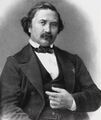Template:Selected anniversaries/March 11: Difference between revisions
No edit summary |
No edit summary |
||
| Line 17: | Line 17: | ||
||1853: Salvatore Pincherle born ... mathematician. He contributed significantly to (and arguably helped to found) the field of functional analysis, established the Italian Mathematical Union (Italian: "Unione Matematica Italiana"), and was president of the Third International Congress of Mathematicians. The Pincherle derivative is named after him. | ||1853: Salvatore Pincherle born ... mathematician. He contributed significantly to (and arguably helped to found) the field of functional analysis, established the Italian Mathematical Union (Italian: "Unione Matematica Italiana"), and was president of the Third International Congress of Mathematicians. The Pincherle derivative is named after him. | ||
||1870: Louis Jean-Baptiste Alphonse Bachelier born ... mathematician at the turn of the 20th century. He is credited with being the first person to model the stochastic process now called Brownian motion, as part of his PhD thesis The Theory of Speculation. Pic. | |||
File:Harry Laughlin.jpg|link=Harry H. Laughlin (nonfiction)|1880: American eugenicist and sociologist [[Harry H. Laughlin (nonfiction)|Harry H. Laughlin]] born. He will be the Superintendent of the Eugenics Record Office from its inception in 1910 to its closing in 1939, and among the most active individuals in influencing American eugenics policy, especially compulsory sterilization legislation. | File:Harry Laughlin.jpg|link=Harry H. Laughlin (nonfiction)|1880: American eugenicist and sociologist [[Harry H. Laughlin (nonfiction)|Harry H. Laughlin]] born. He will be the Superintendent of the Eugenics Record Office from its inception in 1910 to its closing in 1939, and among the most active individuals in influencing American eugenics policy, especially compulsory sterilization legislation. | ||
Revision as of 12:46, 20 November 2018
1811: Mathematician and astronomer Urbain Le Verrier born. He will predict the existence and position of Neptune using only mathematics, an event which will be widely regarded as one of the most remarkable moments of 19th century science.
1821: Poet, painter, and printmaker William Blake publishes his award-winning illustrations of demons and angels. A generation later, mathematicians will discover hidden clues to imminent crimes against mathematical constants.
1822: Mathematician, economist, and academic Joseph Louis François Bertrand born. He will work in the fields of number theory, differential geometry, probability theory, economics and thermodynamics.
1823: Publication of Niles Cartouchian and Anton Rhodomunde Confront Gnotilus causes widespread debate about the role of private citizens in fighting crimes against mathematical constants.
1880: American eugenicist and sociologist Harry H. Laughlin born. He will be the Superintendent of the Eugenics Record Office from its inception in 1910 to its closing in 1939, and among the most active individuals in influencing American eugenics policy, especially compulsory sterilization legislation.
1971: Inventor Philo Farnsworth dies. He made many crucial contributions to the early development of all-electronic television.
1996: Engineer and inventor Charles William Oatley dies. He developed of one of the first commercial scanning electron microscopes.
- Rudolph Hell.gif
2002: Inventor and engineer Rudolf Hell dies. He invented the Hellschreiber teleprinter system.
2018: Signed first edition of Red Spiral stolen The State Hermitage Museum in Saint Petersburg, Russia, during a stealthy overnight heist allegedly masterminded by the Forbidden Ratio gang.







